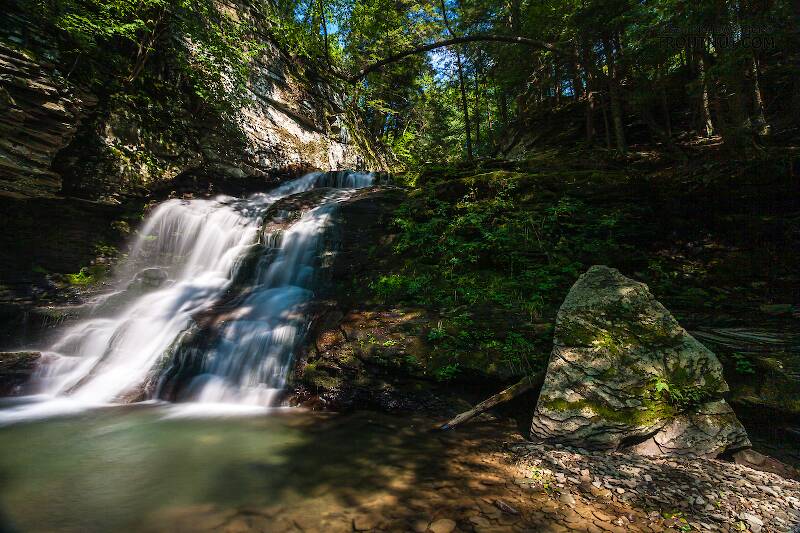
Blue-winged Olives
Baetis
Tiny Baetis mayflies are perhaps the most commonly encountered and imitated by anglers on all American trout streams due to their great abundance, widespread distribution, and trout-friendly emergence habits.

I'm calling this one Pycnopsyche, but it's a bit perplexing. It seems to key definitively to at least Couplet 8 of the Key to Genera of Limnephilidae Larvae. That narrows it down to three genera, and the case seems wrong for the other two. The case looks right for Pycnopsyche, and it fits one of the key characteristics: "Abdominal sternum II without chloride epithelium and abdominal segment IX with only single seta on each side of dorsal sclerite." However, the characteristic "metanotal sa1 sclerites not fused, although often contiguous" does not seem to fit well. Those sclerites sure look fused to me, although I can make out a thin groove in the touching halves in the anterior half under the microscope. Perhaps this is a regional variation.
The only species of Pycnopsyche documented in Washington state is Pycnopsyche guttifera, and the colors and markings around the head of this specimen seem to match very well a specimen of that species from Massachusetts on Bugguide. So I am placing it in that species for now.
Whatever species this is, I photographed another specimen of seemingly the same species from the same spot a couple months later.

Mayfly Species Nixe perfida
Species Range
Physical description
Most physical descriptions on Troutnut are direct or slightly edited quotes from the original scientific sources describing or updating the species, although there may be errors in copying them to this website. Such descriptions aren't always definitive, because species often turn out to be more variable than the original describers observed. In some cases, only a single specimen was described! However, they are useful starting points.
Male Spinner
Wing length: 7 mm
Mesonotum brown; abdominal tergites rather deep brown with pale median and submedian streaks; genitalia of the lucidipennis type (now a synonym of Nixe lucidipennis) (see fig. 96).
Eyes pale bluish white in living insect. Head yellowish tinged with ruddy; below each lateral ocellus near the margin of the eye is a round black spot. Thoracic notum brown; anterior sutures tinged with ruddy; scutellum paler. Pleura and sternum light yellow, pleura with faint ruddy shading at bases of legs. Fore legs light yellow at base; femora pale at extreme base, otherwise deep reddish brown; tibia smoky yellow with a black spot apically; tarsi smoky. Middle and hind legs pale yellowish; femora with ruddy tinges, tibiae with faint reddish streaks at base. Wings hyaline; venation pale, veins fine; costal cross veins indistinct except those of the apical area, which are 12-13 in number, simple and straight.
Abdominal tergites rather deep brown, seeming to be tinged with reddish in certain lights. A narrow pale mid-dorsal line and lunate submedian streaks on each tergite. The lateral margin of the dark area is somewhat oblique on each segment, leaving a pale postero-lateral triangle on each. Sternites pale yellowish. Tails pale, the basal joinings narrowly reddish brown. Third forceps joint much longer than the distal one, these two together fully as long as the second. Apical margin of forceps base distinctly emarginate in the median area, with a rather prominent blunt spine-like projection of each side. Penes with a rounded apical lobe as well as a lateral one; two pairs of median spines, and a lateral spine on each side. Evidently allied to H. inconspicua (now a synonym of Afghanurus inconspicua). This species is larger than H. rusticalis (now a synonym of Nixe rusticalis) or H. inconspicua, to which it is evidently allied. Differs in details of structure of penes from H. horrida (now a synonym of Nixe horrida), its closest ally; also from H. lucidipennis (now a synonym of Nixe lucidipennis).
Start a Discussion of Nixe perfida
References
- Needham, James G., Jay R. Traver, and Yin-Chi Hsu. 1935. The Biology of Mayflies. Comstock Publishing Company, Inc.
Mayfly Species Nixe perfida
Species Range
Resources
- NatureServe
- Integrated Taxonomic Information System
- Global Biodiversity Information Facility
- Described by McDunnough (1926)

